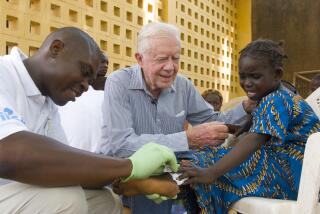WHO GAVE PINTA TO THE SANTA MARIA? Torrid Diseases in a Temperate World.<i> By Robert S. Desowitz</i> .<i> W.W. Norton: 256 pp., $25</i>
- Share via
In 1492, Columbus discovered the New World. In 1493, the Old World discovered a new disease. And what a disease it was--starting with “painful pustules on the private parts spreading to body and face, rashes, ulcers, buboes, black pustules, carbuncles, agonizing and swollen joints, lassitude, fever, rotting flesh, blindness and death . . . the symptoms lingering for years in survivors.” In graphic detail, Nicolo Leoniceno (1428-1524), a professor of physics at Ferrara, Italy, thus portrayed syphilis, the first international STD. Also known as the Great Pox, the French Disease and the Neapolitan Disease, syphilis literally exploded on Europe in the era of seaborne exploration, leaving madness, deformities, aneurysms and stillborns in its wake. All this, according to Robert Desowitz in “Who Gave Pinta to the Santa Maria?” started with Columbus’ men and a stowaway cargo too small for the naked eye to see.
Desowitz is a professor emeritus of tropical medicine and microbiology at the University of Hawaii who specializes in parasite tales. His previous books include “New Guinea Tapeworms and Jewish Grandmothers” and “The Malaria Capers.” In “Who Gave Pinta to the Santa Maria?” he braves deeper waters, charting the migration of so-called “tropical diseases” to temperate climes. Although he darts and weaves around fragmentary facts (remember, our real-time knowledge of microbes is barely 100 years old, so supporting data are scarce), his musings have merit. We may be currently spellbound by “emerging” infections such as HIV, Ebola and Lyme disease but there are still lessons to be learned from adversaries with centuries of global conquest under their belts.
Let’s return to syphilis. It’s not certain that Columbus’ shipmates brought it home as a deadly souvenir of their Caribbean exploits, but it’s likely. Anthropologists favor this theory, focusing on the absence of syphilitic bone lesions in pre-15th century European skeletons. The name Pinta, in Desowitz’s title, refers not just to one of Columbus’ fleet but, an obscure nonvenereal relative of syphilis exclusive to the New World. Even today it occasionally causes sores to erupt on the extremities of tropical residents from Cuba to Mexico and from Central America to the Amazon basin. It requires only casual skin contact for transmission and one whopping shot of penicillin for cure. Desowitz submits that Treponena carateum, the agent of pinta, was a benign predecessor of Treponena pallidum and that it evolved into the corkscrew bacterium of syphilis destined to wreak havoc among the lewd and lusty of 15th century Europe.
To back his argument, Desowitz cites a study of an isolated Amazon tribe: the Kayapo people. In the mid-20th century, the Kayapo were discovered; in 1970, they hosted Yale University researchers eager to track syphilis’ footprints. Although physicals by the New Haven doctors disclosed no stigmata of syphilis, when serum antibodies were tested, virtually all of the tribe’s adult men registered positive. Sadly, the project ended there, its findings incomplete yet tantalizingly suggestive of a nonvirulent ancestor of the Great Pox conferring immune protection upon New World natives. Tropical syphilis’ (or pinta’s) wildfire spread through temperate Europe is, in fact, the mirror image of what happened when measles, smallpox and tuberculosis later came to Amerindians via colonial settlers.
Syphilis is only one of many tropical infections that have at some time or another afflicted tender temperate folk. In “Who Gave Pinta to the Santa Maria?” Desowitz chronicles a whole slew of them, with special emphasis on malaria, hookworm and yellow fever. The latest intelligence along these lines comes from ancient shells of intestinal worms and eggs preserved in mummies and coprolites (that’s right, fossilized stool). There’s even a name for this fecal sleuthing: archeoparasitology.
According to archeoparasitologists and other experts, the first people to arrive in the Americas thousands of years ago were emigrants of Russian-Siberian stock, who came across the Bering Strait. These ancestors traveled from a parasite-inhospitable cold zone so, not surprisingly, their stools lacked nematode eggs, which typically need warm, moist sod in which to germinate. However, South American coprolites, and at least one Andean mummy circa 7000 to 3000 BC, tell a different story because they have shown vestigial traces of Ancylostoma duodenale, hookworms native to tropical-temperate Asia. How did the hookworms make it to South America? Maybe, says Desowitz, in the gastrointestinal tracts of seafarers from the southernmost Japanese island of Kyushu. Distinctive Kyushu-style pottery of the same time period has turned up in excavations along the Pacific Coast of Ecuador.
“Who Gave Pinta to the Santa Maria” doesn’t dawdle in prehistory. Archeoparasitologists can mine so many clues, after all, and those clues seem so, well, dead-ended. Instead, biology springs to life when Desowitz launches into stories about medical fauna unique to South American man and animals, such as mosquito-borne viruses with names like Maituba, Tacaribe and Machupo; the Leishmania parasite, which is siphoned by sand flies from the bodies of sloths and opossums; and the Trypanosoma cruzi parasite, the Latin relative of African sleeping sickness that goes for the heart instead of the head.
Trypanosoma cruzi comes to humans courtesy of the cone-nosed, or kissing, bug that first bites and then defecates after gorging on our blood, befouling the skin punctures with parasites. What a strategy! In Act 2, parasites enter the bloodstream and zero in on cardiac muscle. And there they lurk, inducing silent inflammation until, years later, the curtain literally rings down with terminal heart failure and arrhythmias. To this day, the annual Trypanosoma cruzi death toll from Chile to Mexico averages 50,000 and nearly an equal number of immigrants to the United States carry the ticking time bombs in their chests. (Don’t forget that some of these carriers can unknowingly transmit Trypanosoma cruzi through blood. Does the Red Cross perform antibody screening of transfused units? No. Score another point for Desowitz, who at times transforms his historical account into an eloquent polemic.)
Finally, from indigenous American plagues, Desowitz segues to yellow fever. To many infectious disease historians, this is the ultimate tropical export. With its links to the African slave trade, it might also be viewed as the ultimate microbial revenge for a tragic chapter in human history.
First, let’s set the stage. In the Americas of the 17th to 19th centuries, yellow fever was a disease almost as terrifying as the Black Death. From innocuous flu-like beginnings, it could whiplash, leaving patients jaundiced, delirious and hemorrhaging without offering a clue about how it arrived in the first place. It didn’t travel like typhoid or tuberculosis. What was this appalling phantom?
Until well into the 1800s, this question tormented residents of Spanish Florida, major Southern ports (New Orleans earning the dubious honor of yellow fever capital of the U.S.) and cities as far north as Philadelphia and Boston. Not until 1900 was the mystery partly solved. That’s when Army surgeon Maj. Walter Reed, performing human experiments on American volunteers in Cuba, proved that Aedes aegypti mosquitoes were the bearers of yellow fever. (The second question--what caused it--would have to wait until 1927. But by then mosquito eradication campaigns had largely quelled the temperate outbreaks.)
Although no DNA blood test will ever confirm it, there’s little doubt that yellow fever was on board when white men first set sail from West Africa with human freight in their hold. Equatorial Africa is the original home of yellow fever; it still smolders there in monkeys and men despite a modern vaccine. Of course, there were no vaccines on those 17th century slave boats, just a virus lingering in the bloodstreams of their cowering semi-immune natives and Aedes aegypti mosquitoes breeding in fresh-water casks, ready to transmit the deadly microbes to a new generation of susceptibles. Transmit they did, in chains that eventually led to mini-conflagrations first in the West Indies and finally in other parts of North America. The rest, as they say, is history.
If I ruled the world, Desowitz’s book would be required reading for all medical and public health students, because their course loads, full to bursting with molecular genetics and health policy, leave no time for history. It’s also a good pick if you’re fond of medical lore and willing to chance nightmares of microbial Armageddon. Not that I’m an alarmist. After all, adults the world over are now more likely to die of the habits of affluence than infection; arteries take precedence over mosquitoes. Just remember, with a couple degrees of global warming, Aedes aegypti could happily breed in Southern California. Sweet dreams.






